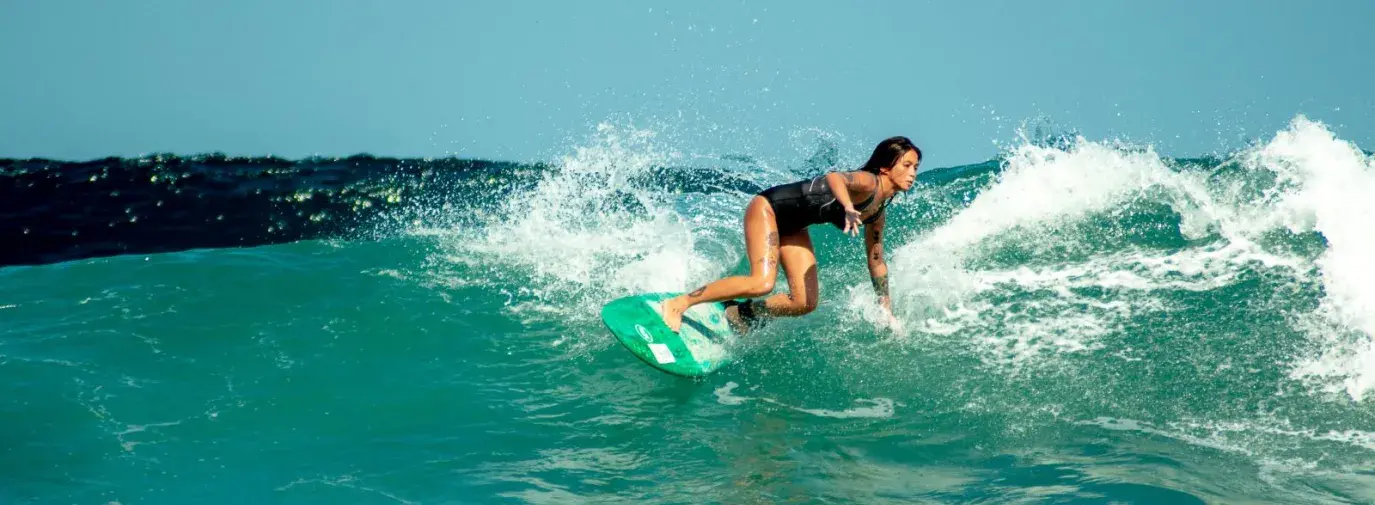
Waves crest and crash in echoing booms as the morning mist floats over the water. In wetsuits and boards under arm, surfers step on to the beach, anticipatory exhilaration burning in their lungs. The power of the ocean beckons—loud, massive, and inviting. Walking deeper, their bodies disappear into the depths as they take part in a centuries-old art form connecting Pacific Islanders to the oceans surrounding their homes.
Over the years, surfing as an art form has weathered many storms. Its cultural origins have been diluted to serve corporate interests and appropriated to titillate Western fantasies of “island life” while surfing related tourism and competitions damage local ecologies and economies. In recent years, however, surfers, largely from Pacific Islander communities, have actively worked to restore the original connections between people and planet, fusing modern sustainability practices and ancient relationships with nature to protect the art and the oceans it depends on.
Surfers like Michael Stewart, cofounder of Sustainable Surf, are passionate about dispelling the ways surfing has been distorted by commercialism and cut off from its origins in Pacific Islander culture.
“Most brands have been using [surfing’s] undeniable attraction globally for the last century to sell us everything under the sun,” he states.
He calls it “the real tragedy of the history of modern surfing culture,” lamenting how people have lost sight of what riding the waves truly means.
“Native Hawaiian culture that gave the gift of surfing to the world, originally infused sustainability and regeneration into all facets of surf culture,” Stewart says. “It was simply another expression of their own deeply sustaining cultural traditions that truly valued the health of the land, the sea and their own communities.”

The Origins of He’e Nalu
Early evidence of surfing dates to 12th century Polynesia, in cave drawings depicting people riding waves. Polynesians brought surfing to Hawai’i and the sport became deeply integrated with Hawaiian life.
But as white American settlers and Christian missionaries began forcibly occupying the islands, they shunned and oppressed Hawaiian culture and religion, including the art of he’e nalu, or “wave sliding.” It wasn’t until the turn of the century, and the explosion of tourism and birth of Duke Kahanamoku in 1890, that surfing began making its comeback.
“The Duke,” as he was nicknamed, was an accomplished surfer and Olympic swimmer. In the early 1900s, after retiring as an Olympian, Kahanamoku toured a swimming exhibition. From Australia to California, he showed off his prowess, and began adding surfing to his exhibitions.
For many Asian and Pacific Islander surfers, however, this art was always a part of their lives. Filipino surfer and writer Camille Pilar refers to the balangay, a wooden canoe-like vessel originating in the Philippines, that a person could ride over waves, not unlike a surfboard.
“I believe that Filipinos have always been wave-riders and voyagers,” Pilar says. “Building a surfing community therefore involves reviving this narrative so that Filipino surfers can remember that wave-riding is in our blood.”
Following America’s illegal annexation of Hawai’i and co-opting of the sport, systemic racism stamped out the fire of its cultural history and surfers’ intimate relationship with nature, including caring for the waves they rode. Millions watched surfing during the Paris 2024 Summer Olympic Games amongst the islands that originated surfing—in Tahiti, colonized by France during the 19th century and still part of the overseas collective known as French Polynesia.
The Western world’s commercialization and co-opting of surfing—like the Olympic spectacle that hasn’t recognized surfing’s cultural origins or history of conservation—has led to a surge of negative effects.
Surfing’s popularity can pose environmental risks like “impacts on local flora and fauna due to trampling over sand dunes or encroachment on bird nesting areas,” according to a 2022 study in Science of the Total Environment. Additionally, a 2021 study in Front Sports Act Living by Tommy Langseth and Adam Vyff revealed most surveyed surfers (51%) bought a new surfboard and/or wetsuit every year, or every other year. Modern boards and wetsuits are made of non-biodegradable materials like plastic and neoprene, a synthetic rubber, which are not environmentally friendly.
Due to the resulting damage, advocates within surfing communities are using their love of the sport to change the tide.
Going Back to the Depths
When Stewart co-founded Sustainable Surf in 2011, his goal was to create a nonprofit that could harness the “unstoppable appeal” of surfing to heal the oceans.
Sustainable Surf heads two global projects: SeaTrees, which plants and protects coastal ecosystems; and ECOBOARD, which certifies the creation of high-performance surfboards.
Sustainable Surf’s self-produced World’s 1st Life Cycle Assessment study for surfboards revealed it’s not just materials that have a negative impact on the environment, but the building process, too. According to its 2023 report, poly boards pose numerous environmental pitfalls. Each produces twice its weight in waste (anywhere from 12-30lbs), create a significant carbon footprint, and are made to be disposable.
Using a list of 20 Qualified Materials and third-party documentation, Sustainable Surf works with both manufacturers and surfboard builders to certify environmental claims and determine if a board meets the qualifications to be an ECOBOARD. Since its inception in 2012, around 500,000 boards have been manufactured and certified as ECOBOARD.
Pilar thinks it’s the perfect time for this conversation: “We need to educate the young surfing community about alternatives to the surf craft and accessories we use.”
For example, Pilar notes how there are now local surf wax makers who produce organic wax as a more environmentally friendly alternative to traditional waxes that contain harmful ingredients like paraffin, a by-product of petroleum, and carcinogens like acrolein.
Stewart agrees that educating surfers about the environmental costs of commercially manufactured surfing equipment and gear is pivotal.
“The real sense of community, all based on a shared love of riding waves in our one global ocean, can be harnessed to not only enjoy the ocean, but to restore and protect it,” he says.
Building Community in the Swell
Gentrification and the pursuit of profits at the expense of community well-being and environmental justice doesn’t just threaten the beaches and coastal waters of the surfing world, they put our entire co-existence with the natural world at risk. Pilar says that without developing an intimate relationship with nature and giving oneself over completely to the raw power and impartiality of the ocean, humans “cannot develop a relationship with nature.”
For Pilar and others, surfing provides that opportunity. Thanks to their efforts, surfing is on the precipice of reclaiming its rightful place amongst its history and culture, proudly shared and properly attributed. By rebuilding the connections between surfing, culture, and environmental stewardship, Pacific Islanders are exploring their personal relationships with their identities, communities, histories, and the world at large.
“Last year, Rogelio ‘Jay-R’ Esquivel Jr. Became the first Filipino to qualify for the World Longboard Tour,” Pilar says. “He awakened a community of Filipino surfers in the diaspora and they realized they were good enough to surf globally and win.”
She continues: “Beach cleanups have become a welcome addition to many event programs in La Union. Before, only a few local players would take up the initiative (La Union Surf Club, Project curma). Now, just about anyone can organize a beach cleanup in line with their brand activations, bar promotions, and other related beach events. (Learn how to organize your own beach clean up on p. 24.) And to look outside of La Union, this practice is also being practiced more in other surf spots and beaches around the Philippines.”
It represents the hopeful future of this sport, and people’s interest in the honest nature of surfing, including our relationship with the planet.
Sustainable Products for Sun Protection
Whether you’re surfing or simply going to watch people catch waves, skin protection is non-negotiable. For sunscreen, opt for reef-safe and natural products, like these from Green America’s Green Business Network members:
- Day Cream — Normal/Dry and Sensitive/Combination from Be Green Bath and Body
- Sol Intense SPF 30 from Lotus Moon Skincare
- Power Repair Daily Moisturizing Sunscreen, SPF 15/ Sun Salve SPF 27/ Sierra Madre Sun Cream SPF 30/ Comfrey Lip Balm from Super Salve
- Sun Products from Green Eco Dream
- Sunscreen from Dolphin Blue
- Essentials Oils (Peppermint, Lavender, Eucalyptus, Tea Tree) that soothe sunburns from Be Moxe
- Exotic Earth Aloe Vera Spray from Castle Baths







